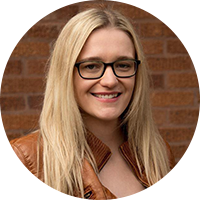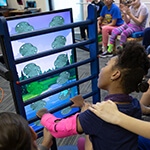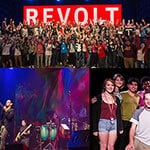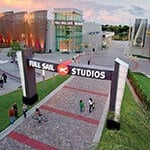Full Sail Stories
Published Nov 03, 2022
From Pitching to Post-Production: The Full Sail Student Film Experience
Students studying film get the full moviemaking experience working on original student films that are written, directed, and shot on campus.
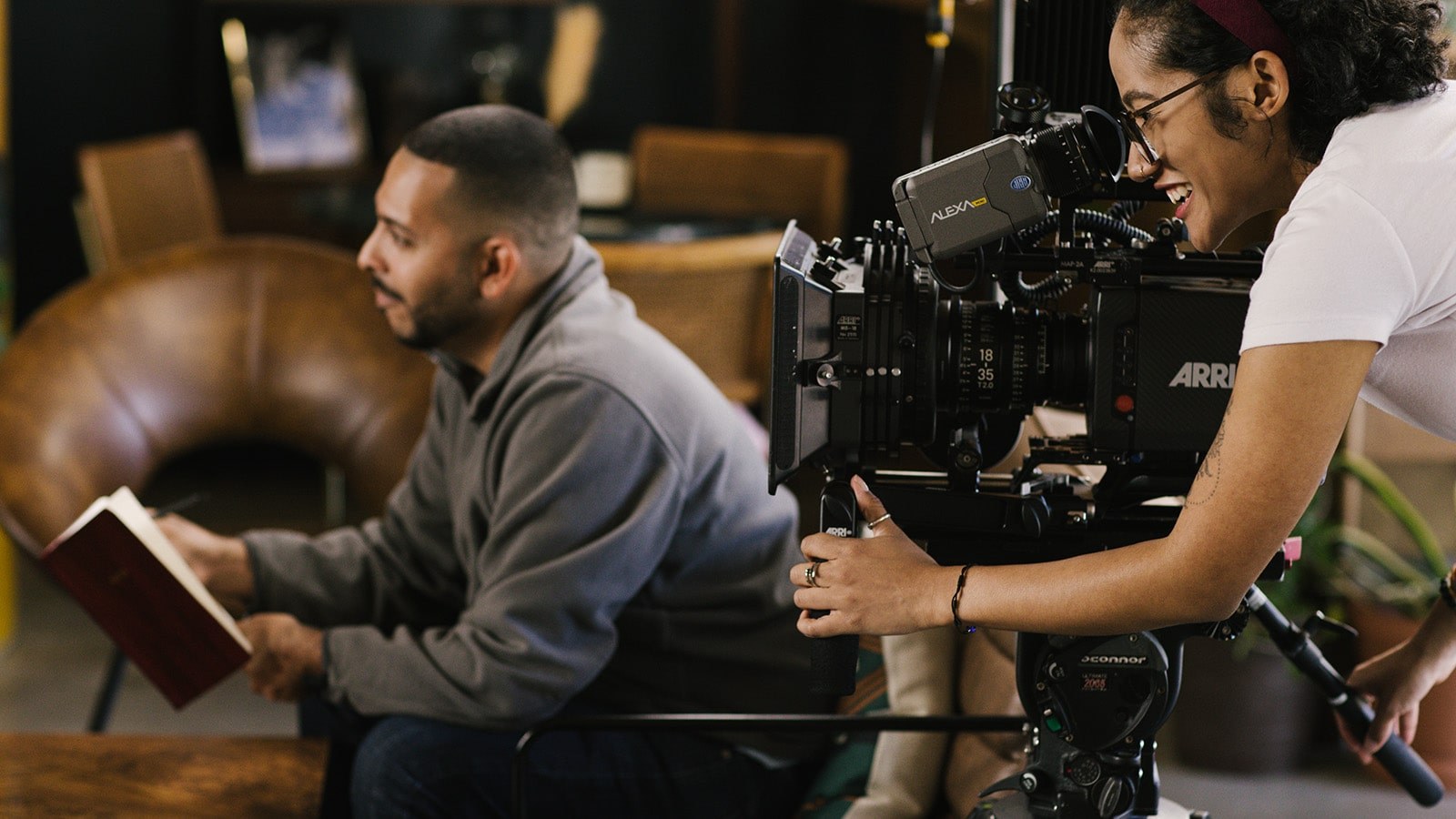
There’s a white casket in the center of the room, but the mood around it is surprisingly upbeat. A few feet away, two people have a spirited conversation as they use an industrial-strength vacuum cleaner on a 10’ x 10’ rug. A young woman asks if anyone knows where the circular saw is, and the scent of paint and wood chips fills the air. There’s no funeral here: The casket is part of the set for The Ghost That Stays With Us, a recent student film project at Full Sail, and the class is building the story’s funeral home during their Art Day lab.
Building a set is just one step in the curriculum. Students learning about film also write scripts, participate in hands-on labs, and create their own crew for a multi-day shoot. These real-world classes let aspiring filmmakers experience moviemaking from start to finish and give them a realistic idea of what to expect in the film and television industry.
Choosing a Story
The hands-on work for The Ghost That Stays With Us, a drama about a veteran struggling with Post-Traumatic Stress Disorder, starts months before the first scenes are shot. Students submit original scripts for consideration in the advanced production project, then film faculty interview students to select a script and a director. Students whose scripts aren’t chosen shoot their movies on a smaller scale at the end of the curriculum.
Once a script and director are locked in, faculty members “hire” other classmates for key roles like Director of Photography, Production Designer, and Art Director. The remaining students are each given a role on teams like Production (Script Supervisor, Production Assistant), Camera (Camera Operator, VTR Operator), Grip (Best Boy Grip, Dolly Grip), Lighting (Gaffer, Electric), Sound (Sound Mixer, Boom Operator), Makeup and Hair, Wardrobe, Art Department (Art Production Assistant, Weapons Wrangler), Set Decoration, and Post-Production.
Preparing with Labs
Specialized labs take place during the weeks leading up to the shoot; they give students a deep dive into their specific crew roles and how those roles contribute to the project as a whole. In the dolly labs, instructors demonstrate how to configure and maintain camera dollies (wheeled carts that help the camera create smooth horizontal shots), and students practice tracking the dollies over uneven terrain. In the camera labs, students learn basics like how to load film and choose the best lens for a shot, then they build a camera for their upcoming movie.
Most student film shoots at Full Sail require multiple Art Days, where the class builds their set on Full Sail’s soundstages. They have access to walls of carpets, furniture from different eras, a rainbow of paint options, scrap wood, fully loaded tool cabinets, and construction equipment like saws. The class working on The Ghost That Stays With Us built three distinct sets (a living room, a funeral home, and a workshop) right next to each other on a single soundstage.
During the Sound Lab, students master the technical skills and creative thinking needed to build a film’s sound story. They consider their project’s tone, the director’s vision, and the script’s unique requirements as they select their movie’s equipment. The Ghost That Stays With Us had several shots inside vehicles, so students worked with faculty to figure out which microphones to use and where to place them to capture spoken lines inside the cars.
The Continuity & Coverage Lab helps students prepare the movie’s shot lists. They use the concepts of coverage (recording all of the shots and audio needed to tell the story) and continuity (making sure that a scene’s visual elements stay in the same place from one take to the next) to figure out the best order to film their shots. Mastering continuity and coverage makes it easier to stitch the film together during post-production. For The Ghost That Stays With Us, students used this lab to figure out which direction a car in the story needed to enter and exit the frame for a seamless edit.
Reality sets in during the Production Review Lab, when students do a dry run of the shooting process by filming a scene provided by their instructors. It’s the faculty’s first opportunity to observe the students in their individual roles and see how they work together as a crew. Once the Director edits the shots, the class views the cut together and determines what they need to work on before the real filming begins.
Students work under pressure in the following Shoot Lab, where they set up cameras and lights under a two and a half hour time limit and complete 10 practice shots from the script. After the Shoot Lab, they spend a few days on last-minute preparations to get everything just right for their film days.
Film Days
At 9:30 AM on the first day of shooting, students and faculty trickle into the soundstage that holds their completed sets. There’s a coiled yet positive tension in the air as they check in, receive the day’s call sheet, and pack up dollies, cameras, and lights for establishing shots on Full Sail’s Backlot.
Shifting between outdoor and indoor scenes on The Ghost That Stays With Us gives the student film crew experience adjusting lighting, camera settings, and microphones for different environments. A Key Grip and Best Boy Grip set up bounce reflectors and rigging against one of the Backlot’s Brooklyn brownstone facades as a Gaffer and Best Boy Electric carefully hang lights. Once the director calls “Action!”, the Sound Mixer listens closely over a headset to balance microphone volumes as a breeze picks up. The Production Designer and Art Director keep tabs on how the shot’s overall look is coming across on camera.
Once the Backlot shooting is finished, students wrap electrical cords and pack camera lenses and microphones for the trip back to the soundstage. The crew makes a quick break for lunch, chatting about upcoming scenes as they grab sandwiches and cookies from a craft services table in the hallway.
The setup process begins again when students return to the soundstage. Camera operators attach the lenses they chose in their labs and adjust tripods to match the desired sight lines. Students in Hair and Makeup break out combs for actors in the workshop set while a Production Assistant sets a model plane on the workshop’s table. Arranging crew members who are holding boom mics, manning cameras, and shooting behind-the-scenes footage looks challenging, but the students’ weeks of preparation help them seamlessly shift into position.
As the Director, Director of Photography, Production Designer, and other key crew positions give the workshop a final look, the rest of the class prepares for one of the day’s biggest challenges: maintaining quiet on set. Cell phones are shut off or stored outside of the soundstage, the Wardrobe Supervisor double-checks the actor’s costume for loose buttons that could add an irritating “clink” to the film’s sound mix, and Grips move a dolly back and forth to make sure it won’t creak or squeak. The focused silence stands in stark contrast to the chatter from the previous weeks’ labs, but the students don’t need to stop and ask questions during filming thanks to their meticulous planning.
The crew makes repeated adjustments for every shot of the day’s five workshop scenes. They wrap around 7:30 PM, tired but enthusiastic about shooting the next day’s funeral home scenes and their 30-minute trip to Winter Garden for an on-location shoot later in the week.
That’s a Wrap
The crew gets a break from long days once the movie has wrapped, but their job isn’t over yet. They take on post-production work — like adjusting audio tracks, choosing the best takes, and stitching their scenes together — during the editing process. The class has a completed film a few weeks later.
Student films at Full Sail are a celebration of each student’s work as an individual and as a crew member. Their film set experience is just the beginning of each student’s story as they prepare to make their mark on the industry.
